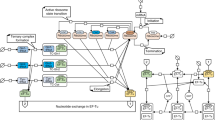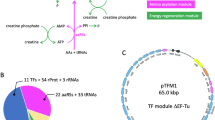Abstract
In Escherichia coli the genes coding for the 52 ribosomal proteins (r-proteins) are organized into a number of transcription units located at various regions on the bacterial genome. The expression of r-protein genes is balanced so that individual r-protein synthesis rates change coordinately in response to changing environmental conditions, and significant amounts of free r-proteins do not exist in the cellular pool. We have suggested a model for the balanced regulation of r-protein gene expression, namely that r-protein synthesis and ribosome assembly are coupled so that r-proteins not incorporated into ribosomes prevent the further translation of r-protein mRNA by a feedback regulatory mechanism1. The model was tested in vitro by examining the effect of purified r-proteins on DNA directed r-protein synthesis2,3, and in vivo by examining the effect of overproduction of certain r-proteins on the synthesis rates of other r-proteins4,5. In vitro experiments have revealed that some r-proteins (L1, L4, L10, S4 and S8) can selectively inhibit the synthesis of r-proteins whose genes are in the same operon as their own, and that this specific feedback regulation occurs at the level of translation rather than at the level of transcription of mRN A2,3,6,7. Regulatory roles for L1, S4 and L4 have also been established by in vivo experiments4,5. We have studied further the feedback regulatory properties of S8 in vivo and in vitro, and report here that the protein regulates a part of the spc operon.
This is a preview of subscription content, access via your institution
Access options
Subscribe to this journal
Receive 51 print issues and online access
$199.00 per year
only $3.90 per issue
Buy this article
- Purchase on Springer Link
- Instant access to full article PDF
Prices may be subject to local taxes which are calculated during checkout
Similar content being viewed by others
References
Fallon, A. M., Jinks, C. S., Strycharz, G. D. & Nomura, M. Proc. natn. Acad. Sci. U.S.A. 76, 3411–3415 (1979).
Yates, J. L., Arfsten, A. E. & Nomura, M. Proc. natn. Acad. Sci. U.S.A. 77, 1831–1841 (1980).
Yates, J. L. & Nomura, M. Cell 21, 517–522 (1980).
Zengel, J. M., Mueckl, D. & Lindahl, L. Cell 21, 523–535 (1980).
Dean, D. & Nomura, M. Proc. natn. Acad. Sci. U.S.A. 77, 3590–3594 (1980).
Brot, N., Caldwell, P. & Weissbach, H. Proc. natn. Acad. Sci. U.S.A. 77, 2592–2595 (1980).
Fukuda, R. Molec. gen. Genet. 178, 483–486 (1980).
Laemmli, U. K. Nature 227, 680–685 (1970).
Bonner, W. M. & Laskey, R. A. Eur. J. Biochem. 46, 83–88 (1974).
Laskey, R. A. & Mills, A. D. Eur. J. Biochem. 56, 335–341 (1975).
Polisky, B., Bishop, R. J. & Gelfand, D. H. Proc. natn. Acad. Sci. U.S.A. 73, 3900–3904 (1976).
Clark, D. J. & Maaløe, O. J. J. molec. Biol. 23, 99–112 (1967).
Howard, G. A. & Traut, R. R. FEBS Lett. 29, 177–180 (1973).
Author information
Authors and Affiliations
Rights and permissions
About this article
Cite this article
Dean, D., Yates, J. & Nomura, M. Escherichia coli ribosomal protein S8 feedback regulates part of spc operon. Nature 289, 89–91 (1981). https://doi.org/10.1038/289089a0
Received:
Accepted:
Issue Date:
DOI: https://doi.org/10.1038/289089a0
This article is cited by
-
In vitro reconstitution of functional small ribosomal subunit assembly for comprehensive analysis of ribosomal elements in E. coli
Communications Biology (2020)
-
Analysis of RPS15aE, an Isoform of a Plant-Specific Evolutionarily Distinct Ribosomal Protein in Arabidopsis thaliana, Reveals its Potential Role as a Growth Regulator
Plant Molecular Biology Reporter (2010)
-
The complete amino acid sequence of ribosomal protein S8 fromThermus thermophilus
Journal of Protein Chemistry (1993)
-
E. coli ribosomal protein L10 inhibits translation of L10 and L7/L12 mRNAs by acting at a single site
Nature (1981)
-
Interconnection between assembly and synthesis of ribosomal proteins
Molecular and General Genetics MGG (1981)
Comments
By submitting a comment you agree to abide by our Terms and Community Guidelines. If you find something abusive or that does not comply with our terms or guidelines please flag it as inappropriate.



